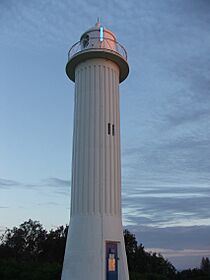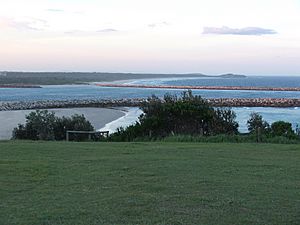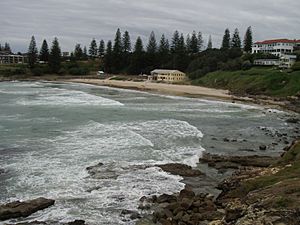Yamba, New South Wales facts for kids
Quick facts for kids YambaNew South Wales |
|||||||||
|---|---|---|---|---|---|---|---|---|---|

Clarence Head lighthouse, Yamba
|
|||||||||
| Population | 6,043 (2016) | ||||||||
| Established | 1854 | ||||||||
| Postcode(s) | 2464 | ||||||||
| Elevation | 29 m (95 ft) | ||||||||
| Location | |||||||||
| LGA(s) | Clarence Valley Council | ||||||||
| State electorate(s) | Clarence | ||||||||
| Federal Division(s) | Page | ||||||||
|
|||||||||
Yamba is a lovely town in the Northern Rivers area of New South Wales, Australia. It is located right where the Clarence River meets the ocean.
The town's main industries are fishing and tourism. Many people also move here to enjoy the warmer weather when they retire.
In 2016 census, Yamba had about 6,043 people living there. But during holidays, the number of people can become three times bigger! In 2009, Australian Traveller Magazine even called Yamba the number one town in Australia.
Contents
Exploring Yamba's Past
Early Discoveries and Growth
In 1799, a explorer named Matthew Flinders landed at what is now Yamba's southern headland. He was looking for a new place to settle. But he thought the river mouth was too dangerous. So, he sailed away.
Later, in the 1830s, people started cutting down trees for timber. The town area was officially mapped out in 1861. By 1862, a post office was built. The town was first called Shoal Bay. Then, in 1885, it was renamed Yamba. At that time, about 340 people lived there.
Yamba Becomes a Tourist Spot
The Yamba Surf Lifesaving Club started in 1908. It is one of the oldest surf clubs in the world! Yamba began to become a popular place for tourists in the 1930s. This happened after the railway line reached nearby Grafton.
At first, visitors stayed in guesthouses. But after the main road was paved in 1958, motels and holiday apartments became popular. People could now use bridges instead of ferries to get around.
Local Industries Over Time
Fishing and oyster farming began in the 1880s. Prawn fishing started in the 1940s. Today, growing sugar cane is a big industry in the area. This became easier after machines started cutting the cane in 1978.
Riverboats used to travel between Grafton and Sydney. But over time, trains and better roads took their place.
What Does "Yamba" Mean?
There are two ideas about where the name Yamba comes from. One idea is that it means "headland" in the local Aboriginal language.
Another idea is that it comes from an Aboriginal word, yumbah. This word means a rough, edible shellfish. It is like an oyster and sticks to rocks.
The Original Custodians of Yamba
The Yaegl and Bundjalung people are the traditional owners of the coastal lands around Yamba. This also includes Iluka and Maclean. The ancestors of the Yaegl people lived near the mouth of the Clarence River. They spoke a language called Yaygirr. It was similar to Gumbaynggirr.
There is proof that the Yaygirr people had permanent homes. They also had a well-developed culture. Matthew Flinders (in 1799) described their large bark huts. These huts had round entrances to keep out wind and rain. Captain Perry (in 1839) also described their very well-made canoes.
Yamba's Busy Port
Since 2011, the Port of Yamba has been managed by the Port Authority of New South Wales. This is a company owned by the Government of New South Wales. The main thing shipped from the port is timber.
Ships also regularly carry general goods from Yamba to Lord Howe Island, Norfolk Island, and New Zealand. In 2012, the port handled about 6,000 tonnes of cargo. It can handle ships up to 120 meters long. Yamba also has private places for repairing boats.
| Historical population | ||
|---|---|---|
| Year | Pop. | ±% |
| 1966 | 964 | — |
| 1971 | 1,280 | +32.8% |
| 1976 | 1,649 | +28.8% |
| 1981 | 2,528 | +53.3% |
| 1986 | 2,880 | +13.9% |
| 1991 | 3,707 | +28.7% |
| 1996 | 4,721 | +27.4% |
| 2001 | 5,621 | +19.1% |
| 2006 | 5,514 | −1.9% |
| 2011 | 6,032 | +9.4% |
| 2016 | 6,043 | +0.2% |
| 2021 | 6,342 | +4.9% |
| Source: Australian Bureau of Statistics data. | ||
Ngaru Village
Ngaru Village is a community for Indigenous people. It is located right by the beach in Yamba.
Exploring the Area Around Yamba
Yamba is surrounded by beautiful nature. It has Yuraygir National Park, the Clarence River, and the Pacific Ocean. The town is also close to other places like Ballina, Lismore, and Grafton.
You can drive from Yamba to Byron Bay in about 1.5 hours. Coffs Harbour is 2 hours away. The Gold Coast is 3 hours away, and Brisbane is 4 hours away. You can also fly to Sydney in about 2 hours.
Yamba's Amazing Beaches
Yamba has eleven beaches within its postcode area! These include Whiting, Turners, Yamba (Main), Convent/McKittricks, Pippi, Flat Rock (Barri Point), and Barri (also called Dump Beach).
Nearby beaches to the north are Woody Head, Iluka Bluff, and Back Beach (Iluka). To the south, you'll find Green Point, Spooky, Angourie Bay, Angourie Point, Back Beach (Angourie), Shelley, Caves, and Plumbago.
Yamba's Climate
Yamba has a humid subtropical climate. This means it has warm, humid summers and mild winters.
| Climate data for Yamba (Yamba Pilot Station, 1877–2016) | |||||||||||||
|---|---|---|---|---|---|---|---|---|---|---|---|---|---|
| Month | Jan | Feb | Mar | Apr | May | Jun | Jul | Aug | Sep | Oct | Nov | Dec | Year |
| Record high °C (°F) | 42.5 (108.5) |
41.5 (106.7) |
34.7 (94.5) |
33.1 (91.6) |
29.4 (84.9) |
28.1 (82.6) |
29.6 (85.3) |
36.1 (97.0) |
35.7 (96.3) |
38.6 (101.5) |
41.9 (107.4) |
39.9 (103.8) |
42.5 (108.5) |
| Mean daily maximum °C (°F) | 26.7 (80.1) |
26.8 (80.2) |
26.1 (79.0) |
24.3 (75.7) |
21.8 (71.2) |
19.6 (67.3) |
19.0 (66.2) |
20.1 (68.2) |
22.0 (71.6) |
23.4 (74.1) |
24.7 (76.5) |
26.0 (78.8) |
23.4 (74.1) |
| Mean daily minimum °C (°F) | 20.2 (68.4) |
20.3 (68.5) |
19.3 (66.7) |
16.5 (61.7) |
13.3 (55.9) |
10.8 (51.4) |
9.7 (49.5) |
10.5 (50.9) |
13.0 (55.4) |
15.4 (59.7) |
17.4 (63.3) |
19.1 (66.4) |
15.5 (59.9) |
| Record low °C (°F) | 14.4 (57.9) |
14.5 (58.1) |
8.7 (47.7) |
7.2 (45.0) |
5.7 (42.3) |
2.7 (36.9) |
2.8 (37.0) |
3.1 (37.6) |
6.2 (43.2) |
6.7 (44.1) |
10.0 (50.0) |
10.9 (51.6) |
2.7 (36.9) |
| Average rainfall mm (inches) | 139.9 (5.51) |
158.5 (6.24) |
183.0 (7.20) |
162.8 (6.41) |
156.5 (6.16) |
134.4 (5.29) |
101.5 (4.00) |
75.3 (2.96) |
59.1 (2.33) |
78.5 (3.09) |
94.1 (3.70) |
116.9 (4.60) |
1,466.4 (57.73) |
| Average precipitation days | 12.6 | 13.7 | 15.8 | 13.4 | 12.4 | 10.6 | 9.2 | 8.1 | 8.4 | 9.7 | 10.2 | 11.3 | 135.4 |
| Average relative humidity (%) | 75 | 75 | 74 | 71 | 67 | 65 | 61 | 60 | 64 | 70 | 72 | 75 | 69 |
| Source: Bureau of Meteorology | |||||||||||||
Yamba's Culture and Fun Activities
Yamba has a relaxed way of life. There are two pubs and two clubs. These include the Pacific Hotel and Yamba Shores Tavern. There's also a golf club called Yamba Golf and Country Club and a bowling club. All of these places often have live music.
Yamba also has many sports and recreation groups. These include the Yamba Buccaneers rugby union club and the Yamba Breakers football club. There's a heated community pool and the Raymond Laurie Sports Centre. You can also find restaurants, cafes, a cinema, schools, churches, a library, and a large marina.
The Yamba Museum is run by the Port of Yamba Historical Society. It shows exhibits about Yamba's story. You can learn about the port, surfing, fishing, and sugar industries. The Old Kirk, next to the museum, also has changing historical displays and art shows.
The busiest times for tourists are December-January, Easter, mid-year, and October. Yamba also has a local radio station called TLC (FM 100.3).
What to See and Do in Yamba
At the northern end of Pippi Beach, you'll find "Lovers Point Rock Wall." From May to October, you might see whales swimming by! Dolphins are also very common around Yamba. You can often see them swimming, surfing, and fishing close to the shore.
There are many local restaurants and boat cruises available. Popular things to do include fishing, surfing, kayaking, bike riding, and camping.
On the fourth Sunday of every month, the Yamba River Markets are held at Ford Park. Here you can enjoy local musicians, fresh food from farmers, food stalls, and arts and crafts. Once a year, Yamba hosts the "Surfing The Coldstream Festival". This festival has an outdoor stage with lots of music. It also features drumming, dancing, art shows, food, and fun rides.
Getting Around Yamba
Buses run through Yamba. The closest airport is Grafton Airport (YGFN). There is also a private airstrip on Palmers Island, just outside Yamba.
Another option is Lismore Regional Airport. It is about 92 km north and has several flights to Sydney every day.
Local Newspapers
- The Daily Examiner
- The Clarence Valley Review
- Clarence Valley Independent
Famous People from Yamba
- Neville William Cayley (1886–1950), a writer, artist, and bird expert, was born in Yamba.
- Kay Cottee, a sailor who sailed around the world, lives in Yamba.
- Ry Cuming (born 1988), a musician, was born on Woodford Island.
- Kane Douglas (born 1989), a rugby union player, was born in Maclean.
- Luke Douglas (born 1986), an NRL rugby league player, was born in Yamba.
- Daine Laurie (born 1984), an NRL rugby league player, was born in Yamba.
- Cameron Pilley (born 1982), a professional squash player, was born in Yamba.
- Tony Priddle (born 1970), an NRL rugby league player, was born in Yamba.
- Donna Urquhart (born 1986), a professional squash player, was born in Yamba.




